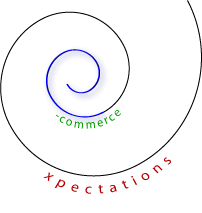If you have started to get the feeling that something new and big is afoot in the consumer Web world, no, you’re not having flashbacks to 1997
 Web 2.0 is a new phenomenon that is beginning to realign the balance of power between producers/providers of products/services and customers because it enables customers to self-organize and wield unprecedented influence in the market. “Web 2.0” refers to a group of (usually) free user-friendly Web applications like blogs, wikis, integrated video/phone services and social networking sites (more below) that enable individuals to connect, collaborate and concatenate with unprecedented ease. E-Commerce (doesn’t it sound quaint now?) first enabled consumers to gain a new level of information about products and services and, as adoption proceeded, to buy over the Web. That was “Web 1.0” and it was still largely one-way communication because information flowed from the Web to customers. “Web 2.0” is focused on letting individuals self-organize, interact, collaborate and be equal players in what aficionados call “the conversation” of the Web. Web 2.0 is a new phenomenon that is beginning to realign the balance of power between producers/providers of products/services and customers because it enables customers to self-organize and wield unprecedented influence in the market. “Web 2.0” refers to a group of (usually) free user-friendly Web applications like blogs, wikis, integrated video/phone services and social networking sites (more below) that enable individuals to connect, collaborate and concatenate with unprecedented ease. E-Commerce (doesn’t it sound quaint now?) first enabled consumers to gain a new level of information about products and services and, as adoption proceeded, to buy over the Web. That was “Web 1.0” and it was still largely one-way communication because information flowed from the Web to customers. “Web 2.0” is focused on letting individuals self-organize, interact, collaborate and be equal players in what aficionados call “the conversation” of the Web.
Before you B2B-focused readers yawn and turn the page, consider that this will turn […]
At the turn of the 21st Century, converging social, technological and political changes demand profound changes in how organizations relate to their customers. These changes question many of the assumptions on which 20th Century businesses are built. To turn this situation to their advantage, executives need to approach how they create value for their customers, quickly and proactively. They must build a collaborative network of partners to discover, design and deliver differentiated experience to customers.
The new meaning of customer experience Pervasive e-business and global sourcing are creating new centers of excellence for knowledge, services and manufacturing around the world—these clusters of people and companies are technology-enabled, well educated and highly motivated. They will impact incumbents in several ways: 1) they represent new collaborative resources that can add significantly to the enterprise expertise network; 2) they are developing into high-growth consumer markets; 3) they will create new offerings that may change the rules of your business since their companies do not have legacy organizations and cost structures. Web 2.0 is mobilizing customers in high-value mature markets—”Web 2.0″ technologies are user-friendly, collaborative tools and work processes that enable customers to connect with each other and collaborate spontaneously. Examples are […]
Dr. Clotaire Rapaille served a delectable elixir to a packed room of B2B marketers at BIGfrontier yesterday. His talk spanned business in China, investing in India, a new value proposition for shampoo (think “breastfeeding”), why people drive Hummers to the mall, why French people don’t work and myriad others. Rapaille (“Rah pEYE”) lists half of the Fortune 100 has retained clients because he has a track record with helping them understand the inner structures of consumers’ minds and, therefore, how to communicate with them. Moreover, many of these inner structures hold true across cultures which can enable companies to develop offerings that will hold true globally. Sound impossible? Read on.
As usual, I will share my notes from the meeting and follow those with some of my insights but, unlike the usual custom, I have also interspersed some material from one of his major books to fill gaps. The topics he addressed were intricate and complex, and there wasn’t time to delve into the details of the background research.
Background
Rapaille, a Frenchman who subsequently became virulently American, began his career as a psychoanalyst working with autistic children in Switzerland, which gave him insights into how the brain worked and […]
Surprises in the Emerging Chinese Consumer Market highlights the Internet-powered practice of consumer collaboration and group buying for discounts.
“Chinese Consumers Overwhelm Retailers with Team Tactics,” The Wall Street Journal, February 28, 2006 is a perfect example of how mature market assumptions can lead to surprises in emerging markets. Chinese consumers increasingly meet on the Internet chat rooms to plan and coordinate a group buying strategy for a type of good or even brand. Then they go to the retailer as a group to extract significant group discounts. This practice is known as tuangou, or team purchase, and can play havoc with companies’ pricing strategies and margins, to say the least.
[…]
In the post-Internet-boom period, it’s easy to forget about some old friends, so here I thought I’d drop in and revisit e-commerce…
 The old joke about commitment being like a ham and eggs breakfast certainly applies to producers (of goods) and consumers in the industrial economy. The punch line is that the chicken (consumer) is involved, but the pig (producer) is committed. The old joke about commitment being like a ham and eggs breakfast certainly applies to producers (of goods) and consumers in the industrial economy. The punch line is that the chicken (consumer) is involved, but the pig (producer) is committed.
A large part of producers’ inflexibility today is due to the fact that they are committed to bits (as opposed to bytes) at all stages of production and distribution: inputs, inventory, safety stocks, unsold goods, returns “… the whole catastrophe,” as Zorba says. These commitments are, in many cases, more important to producers than putting the customer first, and they represent a critical barrier to industrial economy companies’ intimacy with consumers because companies must sacrifice customer needs to maintain their operating realities. (For more on this, see Transformation: from Self-contained Company to Networked Global Organization.)
E-Commerce is steadily liberating producers from this dilemma in many categories. Let’s take a banal example. Probably most readers have shopped at “Earth’s Biggest Bookstore.” For many people, it defined the e-commerce experience. […]
A blog is not like a plant of the desert variety; it needs watering more often, so here’s an excerpt from my imminent Market Advisory on the marketing tectonic shift:
The Mirror: Customer Experience and Intimacy
We will see more changes in marketing practices from 2006-2015 than in the rest of the profession’s history because marketing will be the vanguard for the shift from an industrial economy to a knowledge economy, which will demand competence in all encompassing customer experience in order to achieve differentiation. Similarly, the globalization of markets is accelerating: emerging markets will represent extraordinary potential, but addressing them will demand unprecedented innovation. In a bright spot, ongoing CRM and BI initiatives, combined with continuing standardization of architecture (SOA) and messaging (Web services, XML), will begin to deliver the proverbial 360° view of the customer.
The Customer Experience Imperative
The customer experience will be mandated from producer and consumer quarters. Consumers have product fatigue. In many categories, there are too many choices with little differentiation save price. Producers will have unprecedented information, which they will explicitly use to create experiences. In fact, no consumer wants a product or service anyway; rather, consumers buy products and services in order […]
|
|
 Web 2.0 is a new phenomenon that is beginning to realign the balance of power between producers/providers of products/services and customers because it enables customers to self-organize and wield unprecedented influence in the market. “Web 2.0” refers to a group of (usually) free user-friendly Web applications like blogs, wikis, integrated video/phone services and social networking sites (more below) that enable individuals to connect, collaborate and concatenate with unprecedented ease. E-Commerce (doesn’t it sound quaint now?) first enabled consumers to gain a new level of information about products and services and, as adoption proceeded, to buy over the Web. That was “Web 1.0” and it was still largely one-way communication because information flowed from the Web to customers. “Web 2.0” is focused on letting individuals self-organize, interact, collaborate and be equal players in what aficionados call “the conversation” of the Web.
Web 2.0 is a new phenomenon that is beginning to realign the balance of power between producers/providers of products/services and customers because it enables customers to self-organize and wield unprecedented influence in the market. “Web 2.0” refers to a group of (usually) free user-friendly Web applications like blogs, wikis, integrated video/phone services and social networking sites (more below) that enable individuals to connect, collaborate and concatenate with unprecedented ease. E-Commerce (doesn’t it sound quaint now?) first enabled consumers to gain a new level of information about products and services and, as adoption proceeded, to buy over the Web. That was “Web 1.0” and it was still largely one-way communication because information flowed from the Web to customers. “Web 2.0” is focused on letting individuals self-organize, interact, collaborate and be equal players in what aficionados call “the conversation” of the Web.
 The old joke about commitment being like a ham and eggs breakfast certainly applies to producers (of goods) and consumers in the industrial economy. The punch line is that the chicken (consumer) is involved, but the pig (producer) is committed.
The old joke about commitment being like a ham and eggs breakfast certainly applies to producers (of goods) and consumers in the industrial economy. The punch line is that the chicken (consumer) is involved, but the pig (producer) is committed.